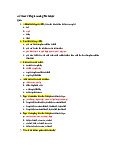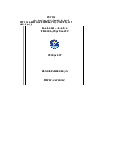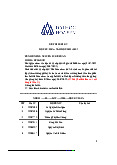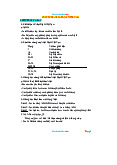











Preview text:
PHỤ LỤC 2
MẪU ĐỀ CƯƠNG MÔN HỌC BẰNG TIẾNG ANH COURSE OUTLINE Course ID Course title Credits QUẢN TRỊ NHÂN SỰ HRM203DE01 03 HUMAN RESOURCE MANAGEMENT
(Applied to Semester: …, Academic year: ….…,
Decision No……./QĐ-ĐHHS dated ……)
A. Course Specifications: Periods Periods in classroom Self- Total Lecture/ Activity Lecture Lab room Fieldwork periods* study Seminar room periods (1) (2) (3) (4) (5) (6) (7) 45 30 15 90 45 00 00
(1) = (2) + (3) = (5) + (6) + (7) B. Other related Subjects: Other related Subjects Course ID Course title Prerequisites: 1. QT106DE02 Principles of management C. Course Description:
This course provides students with the basic knowledge of Human Resource Management
(HRM) like recruiting, selecting, training, and rewarding employees. Those are not just the job of
a central HR group but rather a job in which every manager must engage. The course is delivered
with a combination of the explanation of theories and group discussion of case studies, and conducting of group projects. D. Course Objectives: No. Course Objectives
Provide students with general knowledge of human resource management today. O1. (Chapter 1 & 2)
Equip students with basic knowledge of job analysis and talent management O2. (Chapter 4)
Provides knowledge and applicability to personnel planning, recruitment and O3.
selection (Chapters 5 & 6)
Provide knowledge and applicability to job training, development and evaluation O4. (Chapters 7 & 8)
Provide basic knowledge about Compensation Plan - Employee Benefits and O5.
Labor relations (Chapter 10; 11 & 12) E.
Course Learning Outcomes: No.
Course Learning Outcomes PLOs CLO1.
Students can explain what is human resource management O1 PLO2 1
and the importance of human resource management. CLO1.
Students will be able to present trends that shape human PLO2 2
resource management today. CLO1.
Students can identify equal opportunities and diversity in PLO2 3
managing human resources today. CLO2. O2
Students are able to generalize about talent management PLO2 1 CLO2.
Students can create the job analysis, job description for PLO2 2 several positions. O3 CLO3.
Students have the ability to predict and plan basic PLO2 1 workforces. O3 CLO3.
Students have the ability to select suitable sources of PLO2 . 2
candidates and recruitment methods for each position. CLO3.
Students have the ability to combine selection techniques PLO2 3
to select the best candidates for the required position. CLO4.
Students are able to develop basic orientation and O4 PLO3 1
training programs for employees in the organization.
Students are able to appraise performance and resolve CLO4.
problems related to evaluation and performance PLO3 2 management. CLO5.
Students are able to explain the basic factors for O5 PLO3 1
determining Compensation Plan
Students are able to distinguish between pay for CLO5.
performance policies; Employee Benefits in the PLO3 2 organization CLO5.
Students are able to build and maintain basic Labor PLO4 3 relations programs. F. Instructional Modes: Period Rooms s Lecture 1 45 room Total 45 Requirements:
+ Language used for teaching and learning: Teaching language, textbooks and slides are in English.
+ Requirements for students when taking the course:
• Read the textbook before each class. Learn about the content and situations in advance.
• Complete individual and group assignments.
• Participating in group activities to write reports and make presentations on assigned topics.
• Research related information
+ How to organize the teaching of the subject: The subject is conducted by teaching in class,
combining exercises and analyzing situations for groups and individuals. Maximum number No Modes of instruction Short description Periods of students 1 Traditional class (lecture) Lecture 30 2 Group work Group work: Answer questions, case analysis, 15 group presentations, debate.
G. Textbooks and teaching aids: -
1. Required Textbooks and Materials: Gary Dessler 2019, Fundamentals of Human
Resource Management, Global Edition, Pearson, 5th Edition -
2. Suggested Course Materials: Julie Beardwell & Amanda Thompson 2017, Human
Resource Management: A Contemporary Approach, Pearson, 8th Edition.
H. Assessment Methods (Requirements for Completion of the Course):
1. Description of learning outcomes assessment 1.1 Group project
Students form groups of 4-5 students and work on a topic chosen by themselves or
suggested by the instructor. Then each group must write a report no more than 20 pages in
length and present it orally. The project counts for 20% of the total score 1.2 Individual assignment
Students will be given a lot of assignments and exercises during the courses. The individual
assignment counts for 20% of the total score. 1.3 Final exam
The final exam consists of multiple-choice questions and situation analysis. The test covers
all the knowledge acquired throughout the course. No reference material is allowed.
2. Summary of learning outcomes assessment * For main semester: Duratio Components Assessment Percentage Schedule CLOs n Forms CLO1.1 CLO1.2 CLO1.3 CLO2.1 CLO2.2 Written report Group CLO3.1 and oral 20% Week 2 to 13 assignment CLO3.2 presentation CLO3.3 CLO4.1 CLO4.2 CLO5.1 CLO5.2 CLO1.1 CLO1.2 CLO1.3 CLO2.1 Several in-class CLO2.2 Individual assignments & 20% Week 2 to 12 CLO3.1 assignment exercises given CLO3.2 during class CLO3.3 CLO4.1 CLO4.2 CLO5.1 CLO1.1 CLO1.2 CLO1.3 CLO2.1 CLO2.2 MCQ + short CLO3.1 90 answers/case Final Test CLO3.2 minutes analysis, closed 60% Week 16 or 17 CLO3.3 book CLO4.1 CLO4.2 CLO5.1 CLO5.2 CLO5.3 Total 100% * For extra semester: Duratio Components Assessment Percentage Schedule CLOs n Forms Group Written report 20% Week 2 to 13 CLO1.1 assignment and oral CLO1.2 CLO1.3 CLO2.1 CLO2.2 CLO3.1 CLO3.2 presentation CLO3.3 CLO4.1 CLO4.2 CLO5.1 CLO5.2 CLO1.1 CLO1.2 CLO1.3 CLO2.1 Several in-class CLO2.2 Individual assignments & 20% Week 2 to 12 CLO3.1 assignment exercises given CLO3.2 during class CLO3.3 CLO4.1 CLO4.2 CLO5.1 CLO1.1 CLO1.2 CLO1.3 CLO2.1 CLO2.2 MCQ + short CLO3.1 90 answers/case Final Test CLO3.2 minutes analysis, closed 60% Week 16 or 17 CLO3.3 book CLO4.1 CLO4.2 CLO5.1 CLO5.2 CLO5.3 Total 100% I. Academic Integrity
Academic integrity is a fundamental value that affects the quality of teaching, learning, and
research at a university. To ensure the maintenance of academic integrity at Hoa Sen University, students are required to:
1. Work independently on individual assignments:
Collaborating on individual assignments is considered cheating. 2. Avoid plagiarism
Plagiarism is an act of fraud that involves the use of ideas or words of another person
without proper attribution. Students will be accused of plagiarism if they: i.
Copy in their work one or more sentences from another person without proper citation. ii.
Rephraser, paraphrase, or translate another person’s ideas or words without proper attribution. iii.
Reuse their own assignments, in whole or in part, and submit them for another class.
3. Work responsibly within a working group
In cooperative group assignments, all students are required to stay on task and contribute
equally to the projects. Group reports should clearly state the contribution of each group member.
Any acts of academic dishonesty will result in a grade of zero for the task at hand and/or
immediate failure of the course, depending on the seriousness of the fraud. Please consult
Student Academic Integrity Policy at https://thuvien.hoasen.edu.vn/gioi-thieu/chinh-sach-van-
ban-9.html. To ensure the maintenance of academic integrity, the university asks that students
report cases of academic dishonesty to the teacher and/or the Dean. The names of those students will be kept anonymous. J. Teaching Staff: Email, Phone number, No. Professor’s name Office hours Position Office location Fulltime 1 Nguyen Thuy Giang giang.nguyenthuy@hoasen.edu.vn lecturer to be Fulltime 2 Dao Thi Ngoc Mai mai.daothingoc@hoasen.edu.vn announced lecturer on the first Fulltime 3 Do Thi Thuc Uyen uyen.dothithuc@hoasen.edu.vn session of the lecturer course Fulltime 4 Nguyen Ngoc Uyen uyen.nguyenngoc@hoasen.edu.vn lecturer 5 …..
K. Outline of Topics to be covered (Learning Schedule):
* For main semester topics: Week/ Topics Homework References CLOs Meeting /Assignment
Part 1: Introduction to Human Resource Management Chapter 1 - HR in Action Case Managing Human Resource Incident 1: Jack Today Nelson’s Problem
- What is HR Management CLO1.
- Why Is Human Resource Gary Dessler Chapter 2 - HR in 1 Management Important to Chapter 1 & CLO1. 1/1 Action Case All Managers? Chapter 2 2 Incident 2:
- The trends shaping HR CLO1. Carter Cleaning 3 Management Company - A Managing Equal
Opportunity and Diversity Question of Discrimination
Part 2: Staffing: Workforce planning and Employment
Job Analysis and Talent Chapter 4 - HR in Management Action Case
- Talent Management Process Incident 2 CLO2. : 2/2
- The basis of Job Analysis Gary Dessler 1 Carter Cleaning 3/3
- Method of Collecting Job Chapter 4 CLO2. Company - The Analysis 2 - Job Description Writing Job Descriptions
- Writing Job Specifications Personnel Planning and Recruiting
- Workforce planning & forecasting: Forecasting Workforce Chapter 5 - HR in Needs Action Case CLO3.
Forecasting the Supply Gary Dessler Incident 2: 1 4/4 of Inside Candidates Chapter 5 Carter Cleaning CLO3. Forecasting the Supply Company: Getting 2 of Outside Candidates Better Applicants
- Why effective recruiting is important
- Internal source of candidates
- Outsides source of candidates 5/5 Selecting Employees Gary Dessler Chapter 6: CLO3. 6/6
- The basis of testing and Chapter 6 Discussion 6.1 & 3 selecting employees 6.3 - Types of tests Chapter 6 - HR in Action Case
- Interviewing Candidates Incident 2 :
- Using other selection Honesty Testing at techniques Carter Cleaning Company
Part 3: Training and Human Resource Development Training and Developing Employees Chapter 7 - HR in
- Orienting/Onboarding New Action Case Employees Incident 2:
- Overview of the Training 7/7 Gary Dessler Carter Cleaning CLO4. Process 8/8 Chapter 7 Company - The 1
- Implementing the Training New Training Program Program
- Implementing Management Development Program
- Evaluating the Training Effort Chapter 8: Performance Management Discussionn 8.4 & & Appraisal 8.5
- Basis concept in Performance Appraisal Chapter 8 - HR in 9/9 - Appraisal Methods Gary Dessler Action Case CLO4. 10/10
- How to deal with Appraisal Chapter 8 Incident 2: 2 Problems and Carter Cleaning - Interview Company - The
- Performance Management Performance Today Appraisal
Part 4: Compensation & Total Reward Developing Compensation Plan Chapter 10 - The Basic Factors in HR in Action Gary Dessler Determining Pay Rates Case Incident 1: CLO5. 11/11 Chapter 10 - Job Evaluation Method Salary Inequities at 1
- Pricing Managerial and AstraZeneca Professional Jobs - 12/12
Pay for Performance and Gary Dessler Chapter 11 - HR CLO5. Employee Benefits Chapter 11 in Action Case 2
- Individual Incentive Plans - Incident 2: Team and Organizational- wide Incentive Plan Carter Cleaning - Company - Pay for Time Not Worked and The Incentive Insurance Benefits Plan
- Retirement and Other Benefit
Part 5: Employee and Labour Relation Maintaining Positive Employee Relations
- Employee Relations Programs for Building and Gary Dessler Chapter 12 CLO5. 13/13 Maintaining Positive Chapter 12 Group Activity 3 Employee Relations 12.12; 12.13
- The Ethical Organization - Managing Employee Discipline 14/14 Group Presentation Revision 15/15 Exam preparation
* For extra-semester topics: Week/ Topics Homework References CLOs Meeting /Assignment
Part 1: Introduction to Human Resource Management Managing Human Resource Chapter 1 - HR in Resource Today Action Case
- What is HR Management Incident 1: Jack CLO1.
- Why Is Human Resource Gary Dessler Nelson’s Problem 1 Management Important to Chapter 1 & CLO1. 1/1 All Managers? Chapter 2 Chapter 2 - HR in 2
- The trends shaping HR Action Case CLO1. 3 Management Incident 2: Managing Equal Carter Cleaning
Opportunity and Diversity Company - A Question of Discrimination
Part 2: Staffing: Workforce planning and Employment
Job Analysis and Talent Chapter 4 - HR in Management Action Case
- Talent Management Process Incident 2: CLO2. 1/2
- The basis of Job Analysis Gary Dessler 1 Carter Cleaning 1/3
- Method of Collecting Job Chapter 4 CLO2. Company - The Analysis 2 Job Description
- Writing Job Descriptions
- Writing Job Specifications Personnel Planning and Recruiting
- Workforce planning & forecasting: Forecasting Workforce Chapter 5 - HR in Needs Action Case CLO3.
Forecasting the Supply Gary Dessler Incident 2: 1 2/4 of Inside Candidates Chapter 5 Carter Cleaning CLO3. Forecasting the Supply Company: Getting 2 of Outside Candidates Better Applicants
- Why effective recruiting is important
- Internal source of candidates
- Outsides source of candidates Chapter 6: Discussion 6.1 & Selecting Employees 6.3
- The basis of testing and selecting employees 2/5 Chapter 6 - HR in - Gary Dessler CLO3. Types of tests 2/6 Chapter 6 Action Case 3
- Interviewing Candidates Incident 2 :
- Using other selection Honesty Testing at techniques Carter Cleaning Company
Part 3: Training and Human Resource Development 3/7
Training and Developing Gary Dessler Chapter 7 - HR in CLO4. 3/8 Employees Chapter 7 Action Case 1
- Orienting/Onboarding New Incident 2:




